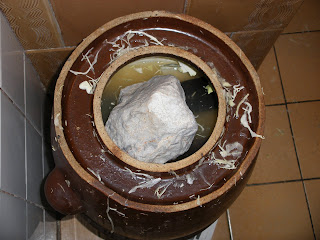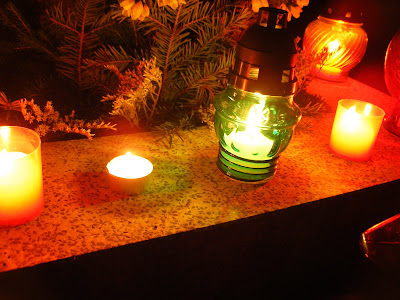Stužková is a ceremony that has no parallel in American culture. It’s held for and by the fifth year students late in the fall. It’s not a graduation ceremony, although it’s similar in some ways, and it’s not a prom, though dancing is a big part of stužková. On our school calendars,stužková is translated as a “ribbon ceremony,” and the word for ribbon is stuha. One major part of stužková is the giving of green ribbons to all of the students. The ribbons symbolize their hopes for the future (including that they will pass all of their exams), and the students wear their ribbons until the end of the year. Anywhere you go in Slovakia you’ll now see kids with green ribbons on their jackets and bags, so you know they’re in their final year of high school. The ceremony is also a coming-of-age type ritual; they’re now adults. (Remember, fifth years are superseniors, and students start “high school” when they’re anywhere from 14 to 16; so some of my oldest students are already 19 and 20 years old.) Stužková requires several costume changes, but the students begin in formal dress, and the majority of the guests, especially parents, also dress formally.

Our stužkovás* start at 6 p.m. When guests arrive, they’re escorted to their seats at long tables. The headmistress and her husband, and the class teacher and her husband are usually at a head table. When everyone is seated, the students process in, and bow or curtsey to the headmistress and their class teacher. Then the students acting as emcees welcome everyone to the stužková. One of the students gives an address, then the headmistress does the same. The students are introduced and their class teacher pins on their ribbons. The school chaplain prays, and a parent makes a short speech and proposes a toast. The students sing “Gaudeamus Igitur.” Then there is a receiving line where all of the teachers shake their students’ hands and offer them some kind of bon mot. Mostly I just told them congratulations, and commented if they looked especially nice.
After the welcomes and speeches and formal toasts and appetizers, the dancing starts. Students first dance with a member of their family, most often their mother or father. Unlike at home, dancing is something that everyone learns here, so it’s incredible to see goofy kids dancing really well. After the family dance, there is the teacher-student dance. This is the subject of speculation among the teachers during the days leading up to stužková. Sometimes students will let slip which teachers they’re dancing with, but usually they don’t tell, so I always wonder who I’ll dance with. So far I’ve been fortunate to dance with really pleasant young men, who have excused my complete inability to dance. Once those dances have been completed, there is open dancing. The kids may dance with their parents again, or with a boyfriend or girlfriend, or a sibling, or a favorite teacher. Parents and teachers also dance.
Dinner is served next. At three of the four stužkovás I’ve attended, it’s been chicken cordon bleu, rice, fries, corn, and cabbage; at the other it was chicken topped with ham, a half a Georgia state fruit,† and cheese, then rice, fries, and some fruit. The tables also have rolls, cakes, and a selection of beverages, including wine, water, Kofola, orange juice, and fruit brandy, on them. It is acceptable for parents to BYOB.
More dancing after dinner. At this point the DJ usually throws on some waltzes, tangos, and Slovak folk music. Around 9:30ish (I never wear a watch nor have my phone at stužková) the students’ program will start. The program usually includes singing, dancing, and skits. At 5A’s stužková, one of the students did a brilliant impression of the Slovak philosophy teacher, which included calling Francis Bacon “Slaninou,” which is bacon in Slovak. Both stužkovás last year included a skit about the Slovak folk hero Jánošík.
When the program is over, there is…more dancing! Many of us use this opportunity to go outside and cool off, because it gets quite warm in the room, and to talk to former students who have come back to see their friends. This goes on until midnight. At midnight the students light candles, read short poems about each other, and get a special piece of cake. Then they often play the stužková song‡ and the kids jump around and dance to that.

This year, the 5Bs had a really cool extra part after the midnight program. They all got dressed in the folk costume from their home region and came out and danced and sang. They also had a folk band come in and play so that they could dance all the better. In the video, not only can you see the ridiculously omnipresent photographers, but hopefully you can tell that everyone around us was singing along to the song. That kind of thing always makes me want to be able to sing along, too.
After the midnight program they bring out more snacks (the infamous meat plate, potato and/or pasta salad, more rolls) and coffee. There’s more dancing, and the headmistress usually leaves around 1 a.m. The other teachers must stay until she leaves, so once she’s gone home, we’re free to either head out or get crazy on the dance floor. The DJ starts to play dance music, and the kids disco it up until morning. The latest I’ve stayed was until around 3:15 this past week, but some teachers literally stay all night. Nine hours was enough for me.

If you’re lucky, you get to sleep in the morning after stužková; but if you’re up and around, you’ll see kids heading home from the party, or getting on buses. And hopefully by Monday morning everyone is recovered enough to be back at school and functioning normally.
Stužková is one of those things that's so important that people can't explain why it's important. It just is. I hope I've been able to describe it well enough to show some of that. Despite whether or not I return to teach here next year, this won't be my last stužková; I'm already making plans to come back in 2012 for the current 2B's stužková.
*Improper Slovak alert. It’s fun putting the English plural ending on Slovak words, though, and easier than memorizing the Slovak plural endings.
†“Peach” sounds like a very vulgar word in Slovak, so we try not to go around saying it a lot.
‡I hope it gets stuck in your head as much as it's stuck in mine right now. Also, that video is quite amusing.



